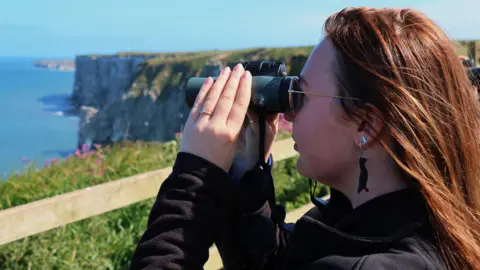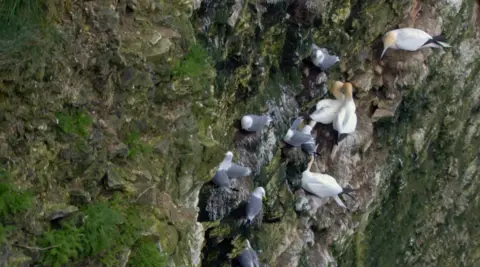Reserve named first Shorewatch site in England
 Ellen Leach
Ellen LeachA nature reserve has become the first site in the UK to carry out "structured watches" to monitor marine mammals in the North Sea.
RSPB Bempton Cliffs in East Yorkshire will have 28 volunteers looking for minke whales, dolphins and grey and harbour seals.
The project, called Shorewatch, is a partnership between the RSPB and Whale and Dolphin Conservation (WDC).
Katie Dyke, the Shorewatch co-ordinator, said: "The data being gathered here will help strengthen our understanding of how cetaceans use the English coastline and how best to safeguard them."
She added: "The high cliffs give excellent visibility, and the volunteer team has been so committed.
"We're not only recording vital data but also inspiring people to care about marine life on their doorstep."
 Richard Ball
Richard BallShorewatch was first launched across Scotland by the WDC in 2005 and RSPB Bempton Cliffs is the first location in England to join the scheme.
Volunteers use specialist marine binoculars to scan the sea for 10 minutes before they log their findings into a dedicated app. The data is then used by experts for national research and conservation strategies.
RSPB Bempton Cliffs is home to about half a million seabirds including gannets, kittiwakes, guillemots and razorbills. About 3,000 puffins also breed at the cliffs each year.
Dave O'Hara, the reserve manager, said: "Visitors travel from right across the UK and overseas to see seabirds in their thousands here, but they also have the chance to spot something spectacular out at sea too.
"We hope to become just as famous for sightings of whales, dolphins and porpoises."
 BBC / Paul Murphy
BBC / Paul MurphyAnalysis - Paul Murphy, Environment Correspondent
If you've been lucky enough to witness the acrobatics of a dolphin pod or a whale engaged in a feeding frenzy, you'll understand why this project is so exciting.
There is perhaps no better place for a survey of this kind than the towering cliffs of Bempton.
It offers a natural vantage point 300ft (90m) above the beach and a vast area of the North Sea is visible.
The project, largely staffed by volunteers, is about much more than entertainment and spectacle.
They are gathering hard data on the habits and movements of whales, dolphins and porpoises.
It has rarely been more important to do this.
The North Sea is an increasingly busy place, hosting everything from industrial fishing to some of the biggest offshore wind turbines in the world.
Scientists are keen to understand the impact human activity is having on such an important natural habitat.
In modern conservation, data is king.
For decades, Bempton's seabird population has been forensically studied.
Now, some of those binoculars are turning away from the nests on the cliffs to scan the waves for flippers and fins.
Listen to highlights from Hull and East Yorkshire on BBC Sounds, watch the latest episode of Look North or tell us about a story you think we should be covering here.
